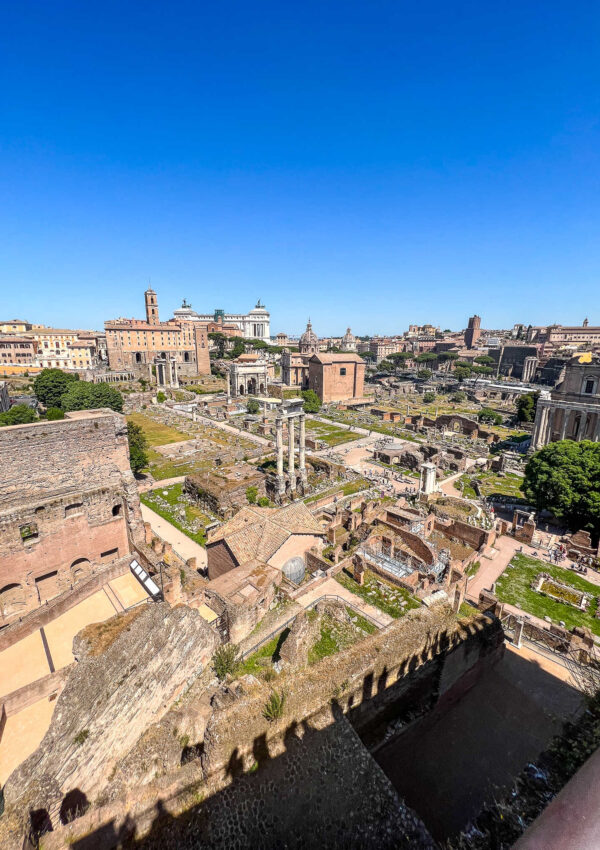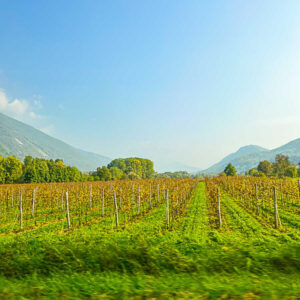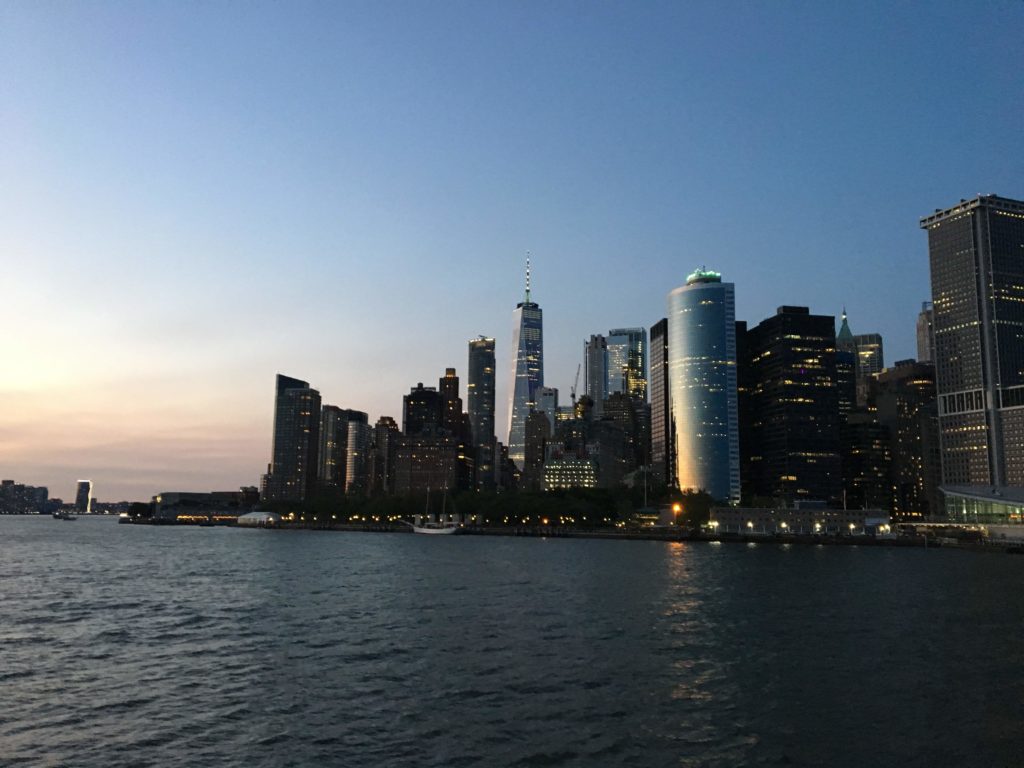Contents
- 1 The Best Non-Touristy Places to Visit in Italy
- 1.1 1. Drive to the top of Tre Cime di Lavaredo in the Dolomites
- 1.2 2. Take an early morning drive through the Italian Alps’ Gavia Pass
- 1.3 3. Experience the Dolomites’ infamous “Italian Front” at Cinque Torri
- 1.4 4. Swim in the emerald waters of Pozze Smeraldine in Tramonti di Sopra
- 1.5 5. Climb to the top of Scala Contarini del Bovolo in Venice
- 1.6 6. Visit the House of Savoy residence, Villa della Regina, on the outskirts of Turin
- 1.7 7. Marvel at the architecture of the Russian Orthodox Church in Sanremo
- 1.8 8. Taste true Tuscan food at Podere il Casale in Pienza
- 1.9 9. Take in the view from the top of Monte Capanne on Elba
- 1.10 10. Check out the bridge nicknamed “Devil’s Bridge,” Ponte della Maddalena, outside Borgo a Mozzano
- 1.11 11. Visit the underground Etruscan caves in Orvieto
- 1.12 12. Explore the Sant’Agnese Fuori Le Mura Basilica and Complex outside Rome
- 1.13 13. See thousands of Capuchin friars’ bones at the Bone Chapel Capuchin Crypt in Rome
- 1.14 14. Wander through the gardens at Villa d’Este in Tivoli
- 1.15 15. Visit Palazzo dei Papi, the home for the first-ever conclave in Viterbo
- 1.16 16. Check out the beautifully preserved ruins of Herculaneum in Ercolano
- 1.17 17. Explore the ruins of the Ancient Greek city Paestum in Paestum
- 1.18 18. Enjoy panoramic views of the Amalfi Coast from the Villa Cimbrone Gardens in Ravello
- 1.19 19. Experience one of the fastest zip lines in Europe at Volo dell’Angelo in Castelmezzano
- 1.20 20. Discover Matera’s Paleolithic cave homes in the Sassi di Matera
- 1.21 21. See the seaside cave church in Pizzo Calabro, Piedigrotta Church
- 1.22 22. Swim inside Roca Vecchia’s Grotta della Poesia, the “Cave of Poetry”
- 1.23 23. Explore the Medieval city center of Erice
- 1.24 24. Marvel at the huge collection of Roman mosaics at the Villa Romana del Casale near Piazza Armerina
- 1.25 25. Escape to the Dolomite Mountains from Bolzano
- 1.26 26. See the ancient trulli houses in Alberobello
- 1.27 27. Marvel at panoramic views of Lake Garda in Sirmione
- 1.28 28. Spend a night in one of Europe’s oldest castles at CastelBrando
- 1.29 29. Climb one of the remaining Medieval towers in San Gimignano
- 1.30 30. Dip your toes in the Tyrrhenian Sea on the Aeolian Islands
- 2 The Best Non-Touristy Things to do in Italy
This post may contain affiliate links! I will receive a commission, at no extra cost to you, if you purchase something recommended here.
It’s not just the incredible food and wine that makes Italy so special.
There’s also its culture, history, art, architecture, and scenery.
But most tourists only see the significant landmarks in the largest cities like Rome, Florence, or Venice.
Although I love visiting Vatican City or the Leaning Tower of Pisa as much as anyone, I (and several of my other favorite travel writers) am going to share with you the best non-touristy things to do in Italy.
These aren’t your typical “must-see” spots–they’re all non-touristy places to visit in Italy that will blow your mind and make you want to book your flights right now.
A UNESCO World Heritage Site is a creation or landmark chosen for conservation by the United Nations Organization for Education, Science and Culture (UNESCO) due to its cultural, historical, scientific or natural significance. It must meet a minimum of one of ten selection criteria to be considered for the World Heritage List, and once chosen, it becomes protected for preservation by various international treaties.
The Best Non-Touristy Places to Visit in Italy
1. Drive to the top of Tre Cime di Lavaredo in the Dolomites

The Dolomites/The Italian Alps, South Tyrol, Italy
If you’re looking for a breathtaking location in Italy without crowds of tourists, head to Tre Cime di Lavaredo.
Tre Cime is a mountain with 3 peaks (hence the name), and the incredible rock formations can be seen from miles away.
What most people don’t know, however, is that you can drive your vehicle up to the top and even, if you’re campervanning in Italy, stay overnight in your van.
You need to pay to be allowed to drive up, and it’s not cheap- about 45€ for 24 hours. However, the views are unlike anything you’ll see anywhere else–simply breathtaking.
There are toilets, a cafe, a gift shop, and the hostel (rifugio) at the top, but very few other services. People come up here to hike, take photographs and enjoy the incredible views.
The most famous hike is the Tre Cime loop, which is about 10km and takes around 3 hours to walk (depending on how frequently you stop to take photos!)
Pay close attention to the weather while you’re up there, particularly hiking the loop or off the beaten path.
You might find yourself surrounded by thick clouds while up there, where you won’t see more than 2ft in front of you!
On the plus side, it clears quickly, and the spectacular views will be visible again.
If the forecast shows lousy weather, you don’t need to bother paying to go up the mountain–without the views, it’s not as incredible.
You definitely need to consider staying up there at least for one night to watch the sunrise over the mountains.
It’s one of the most amazing things you’ll ever see and a definite trip highlight.
By Kathryn Bird from Wandering Bird
2. Take an early morning drive through the Italian Alps’ Gavia Pass
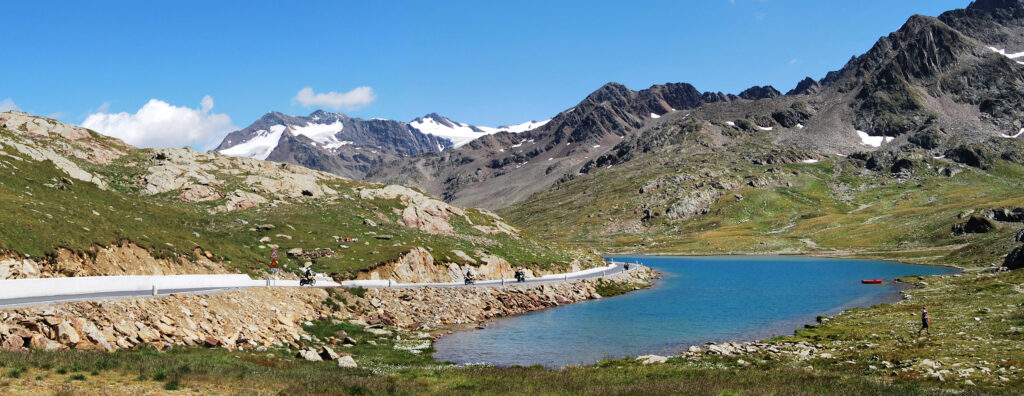
The Italian Alps, Lombardy, Italy
If you’re looking for somewhere to escape the noise and madness of Italian cities, head to the little-known Gavia Pass.
Gavia Pass is a mountain pass high up in the Italian Alps. It’s actually the tenth HIGHEST paved road in the Alps.
This road offers breathtaking views on a sunny day and is a beautiful place to escape and take in the sheer majesty of the mountains around you.
It is single-track in areas, particularly in the southern section, so drive with caution and don’t park up in the laybys- those are passing places to let vehicles pass.
The road’s name is the SP29/ SS330/ SP300 (yes, there are 3) and runs from Bormio south to Ponte di Legno. There are plenty of accommodation options in both places.
It’s in the same region as the famous Stelvio Pass but is less well-known, so fewer motorcyclists and cyclists are whizzing around.
However, if you are motorcycling in Italy, don’t leave the region without riding this road- although you’ll be stopping regularly to take photos of the scenery!
The route does close during winter due to snowfall. You’re usually fine until the end of October, but do check in advance and the road generally reopens when the snows clear in April.
If you’re visiting this area of Italy in the summer, the road is often part of the Giro d’Italia, so check before you set out.
If you’re a nervous driver or don’t like switchbacks, drive it as early as possible–traffic is much quieter then.
By Kat from Biker Girl Life
3. Experience the Dolomites’ infamous “Italian Front” at Cinque Torri

The Dolomites, Veneto, Italy
Designated a UNESCO World Heritage Site, the magnificent Dolomite mountains of northern Italy delight summer and winter travelers.
The Cinque Torri (five towers) rock formation and free outdoor World War I museum enchants visitors that want a slice of culture with their adventure plans.
The site is a popular stop on the Dolomites hiking hut to hut trail called the Alta Via 1.
It is filled with dramatic rocky spires, green meadows, and extraordinary views of mountains reaching almost 10,000 feet.
Scramble along the paths taken by actual soldiers in WWI filled with placards in multiple languages, including English, German and Italian.
You can really feel what it was like to be on the infamous “Italian Front.”
The Dolomites are a true wonder home to skiing in winter and a hiker’s paradise in summer.
Filled with milky blue lakes and impossibly cute mountain villages, this area near Cortina d’Ampezzo requires planning ahead as most lodging is booked 6 months prior.
Cinque Torri is easily reached by car or bus from the town of Cortina d’Ampezzo, which is a 2-3 hour drive from Venice Marco Polo International Airport.
In addition to the ample rock climbing opportunities, multiple mountain rifugios serve delicious hot food.
If hiking isn’t your thing, you can utilize the ski lifts in summer to get to the Cinque Torri.
By Morgan Fielder from Crave the Planet
4. Swim in the emerald waters of Pozze Smeraldine in Tramonti di Sopra

Tramonti di Sopra, Friuli Venezia Giulia, Italy
In Friuli Venezia Giulia, more precisely in the Tramontina valley, within the Friulian Dolomites Park on the shore of the Meduna river, surrounded by a natural landscape made of rocks and white pebbles with lush vegetation and crystal clear waters, you will find a magical place.
In fact, in this idyllic setting, you’ll find the natural pools, called Pozze Smeraldine or Emerald Pools, which the Guardian newspaper included in 2014 among the 10 most beautiful natural pools in Italy to bathe.
An environment that is difficult to find in other Alps areas, the Friuli Dolomites have landscapes of rare beauty.
After you reach the car park (indicated by appropriate signs) in Tramonti di Sopra, leave the car there and follow the signs.
First, they’re placed on the paved road and then on an easy path to follow.
As you proceed, you will come across the source of the Sgurlina, where you can quench your thirst and enjoy the view of an uncontaminated landscape.
After a walk of about 20 minutes, you reach the goal.
Here, the water collects in deep natural pools of a dazzling emerald color, thanks to the white rocks surrounding them.
Since it’s not one of Italy’s hot springs, it’s a perfect platform for a dip in the river’s cool waters.
You can lie down to sunbathe, sit for a picnic, linger and contemplate the landscape.
Insider Tip: Due to an influx of tourists, if you can, avoid visiting the emerald pools in August.
By Miriam from Miry Giramondo
5. Climb to the top of Scala Contarini del Bovolo in Venice

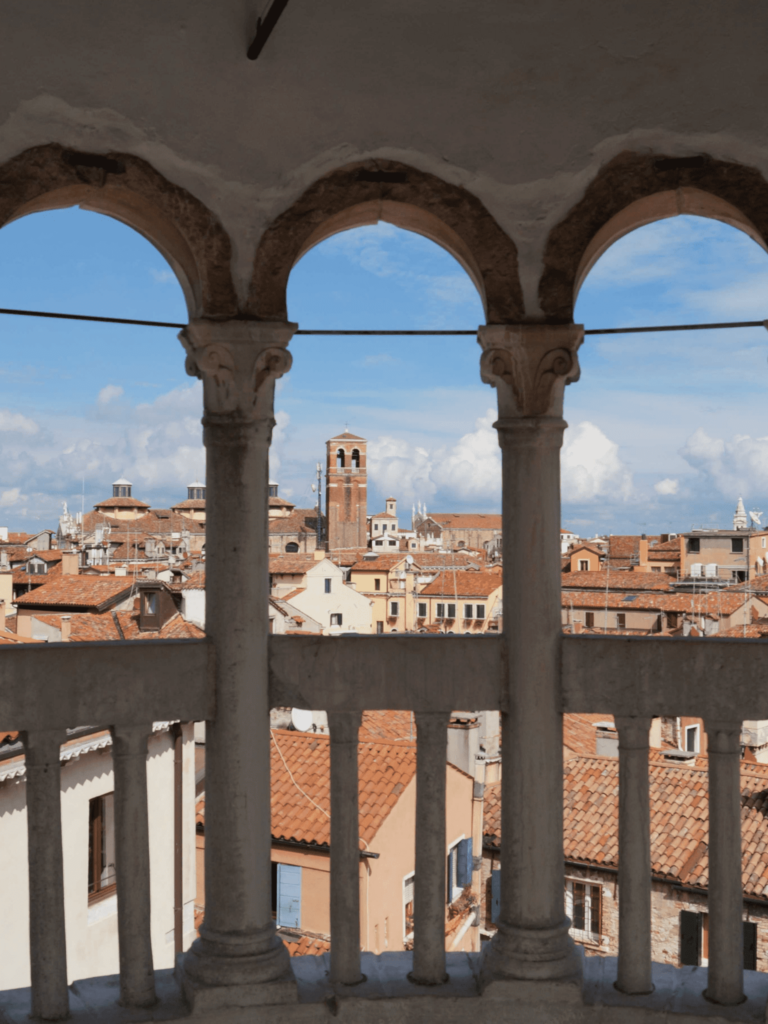
Venice, Veneto, Italy
The Palazzo Contarini del Bovolo is a small palazzo tucked in an alleyway of Venice, best known for its external spiral staircase, the Scala Contarini del Bovolo.
The fifteenth-century Palazzo’s staircase leads to a small arcade with stunning views over the rooftops of neighboring buildings.
This unique staircase deserves to be on your Venice bucket list because of the different architectural styles it combines: Renaissance, Gothic, and Byzantine influences give the stairs’ tower its distinctive look.
The staircase is open for visitors to ascend and enjoy the 360-degree views of Venice from its arcade.
Usually, the staircase is not busy, so take your time photographing the many angles of the heart of Venice.
Visitors must buy a €7.00 ticket to the Palazzo, including access to the palace’s small gallery.
You can also gain entry as an add-on to one of the best city passes in Venice, the Venice Unica Pass.
The Palazzo is off Campo Manin and somewhat hard to find, but you will definitely be rewarded if you’re determined.
If you’ve just arrived in Venice from Florence by bus, arriving at the Tronchetto bus station, make your way east, following the Piazza San Marco signs.
From this famous piazza, wind through the streets as follows: head northwest on Calle de Fabri, take the stairs on the left and turn onto S. Marco.
Turn left on Calle del Magazen, left on Calle Fuseri, and then right on the very narrow Calle de la Vida o de le Locande, and look for the yellow sign pointing you toward the “Scala Contarini del Bovolo.”
There are plenty of accommodation options within a short walk of the Palazzo.
Still, if you want to stay incredibly close, two top hotels are located right on Campo Manin: Hotel Centauro (Booking | Hotels) and Palazzo San Luca (Booking | Hotels).
A more affordable choice is a room at the quaint Ca’ Dei Fuseri Bed & Breakfast.
By Mary King from WanderU
6. Visit the House of Savoy residence, Villa della Regina, on the outskirts of Turin

Turin, Piedmont, Italy
One of the best places to visit in Turin overlooking the city from the eastern side of the River Po, the hilltop Villa della Regina is a lesser-known Italian UNESCO World Heritage Site you don’t want to miss.
The entire region of Piedmont was ruled by the Savoy family for centuries (and Turin was the capital city of several of their kingdoms.)
So, the region is home to more than ten royal residences, all listed as one UNESCO site, and Villa della Regina is one of them.
Built in the 17th century and remodeled throughout the years, it was used by the princes and princesses of the House of Savoy until the 19th century.
While its front facade is relatively modest, on your tour, you can see its luxurious rooms, packed with beautiful frescoes, paintings by famous Italian painters, marble decorations, and more.
Next, head out to the vast gardens dotted with pavilions, sculptures, and fountains.
Last but not least, you’ll see the Villa’s royal vineyard, which was replanted a few years ago.
From Turin’s city center, you can take bus number 56, but the final ascent to Villa della Regina must be done on foot.
The visit costs only 7 euros, but admission is free with the Torino+Piemonte Card.
The Villa is only open from Friday to Sunday, and if you want to visit on Saturday, you must reserve your spot in advance via email.
The best area to stay in Turin is the Historic Center, so you can book a stay at the highly-rated Savoia Suites Torino, though you can also stay in the quiet Crocetta neighborhood at Hotel Liberty (Booking | Hotels).
By Or from My Path in the World
7. Marvel at the architecture of the Russian Orthodox Church in Sanremo


Sanremo, Liguria, Italy
An unexpected sight on the Italian Riviera is a Russian Orthodox Church–called Chiesa Russa Ortodossa or Cathedral of Christ the Saviour–in the elegant port city of Sanremo.
Constructed in 1912-1913, the Cathedral of Christ the Saviour was opened to serve the local well-to-do Russian community.
Another reason for the inauguration of this church was to pay homage to Empress Maria Aleksandrovna, who spent some time in Sanremo.
She was so well-liked in Sanremo that an entire street lined with palm trees has been named after her – the Corso Imperatrice.
While the outside of the church is intricately decorated in vivid colors and rotund domes typical of Russian Orthodox churches, the church’s interior, in stark contrast, remains relatively bare.
The onset of the First World War prevented the completion of the ambitious plan to decorate the interior.
Recently, renovations of the church’s exterior have been completed to repair the damage from the Second World War.
The interior restoration is also in the works so that a richly decorated interior might still come to fruition an entire century after the original inauguration of the church.
The Russian Orthodox Church in Sanremo should be a must-see on every visitor’s itinerary.
Such an unlikely landmark is not often found outside Russia and especially not in Italy.
This small church proudly takes its place on the Sanremo skyline.
The church is located at 2 Via Nuvoloni in Sanremo.
The church is open 10 am – 12:30 pm and 3 pm – 6:00 pm. Sunday service is at 10 am and on Saturdays at 5 pm.
The closest airports to Sanremo are Nice and Turin. For amazing views of the sea, stay at Lolli Palace Hotel (Booking | Hotels) on Corso Imperatrice.
By Bea Cińska from Pack Your Bags
8. Taste true Tuscan food at Podere il Casale in Pienza

Pienza, Tuscany, Italy
Tuscany, Italy, is a beautiful place to visit, but it’s also a great place to taste the local food.
If you love finding non-touristy things to do in Italy and want to learn more about the local history and culture of Tuscany, plan a visit to Podere il Casale, a unique Tuscan cheese farm and restaurant.
Located in the stunning Val d’Orcia in central Tuscany along the ancient pilgrimage road from Rome, Podere il Casale is one of the area’s most delicious farm-to-table restaurants, with all of its cheese produced on-site and much of its produce and meat as well.
Adding to its charm is the scenic location it occupies, overlooking the Tuscan Val d’Orcia where the movie Gladiator was filmed.
The landscape is so iconic; it’s been designated a UNESCO World Heritage site.
The farm is open for cheese tastings and short tours of the grounds and sheep herds, but for a more immersive experience, sign up to take their cheese-making class.
Their expertise in making the local pecorino cheese is undeniable, and cheese tastings also include samples of their own small-barrel wines.
You can purchase cheese and other local foods Podere il Casale produces to take home if it makes it that far.
You’ll need to rent a car to get to this rural location, but in this case, the journey is definitely as good as the destination.
By Lori Sorrentino from Travlinmad
Fun Fact: Italy doesn’t have any laws that mandate the country’s legal drinking age. You can read more about the country’s alcohol consumption laws here.
Read More
- The Best Venice City Pass: An Ultimate Venice Pass Comparison Guide
- Everything I Wish I’d Known Before Visiting Venice, Italy
- 14+ Awesome Rainy Day Activities in Venice, Italy
- 25 Uniquely Interesting Facts About Venice, Italy
- Your Guide to the Best Nightlife in Venice, Italy
- Your Perfect Itinerary for 2 Days in Venice, Italy
- Outstanding Prosecco Vineyard Tours & Wine Tours from Venice, Italy
- Venice vs Rome: Which Italian City Should You Visit?
9. Take in the view from the top of Monte Capanne on Elba

Elba, Tuscany, Italy
Most people only have the beautiful beaches in mind when thinking of the tiny island called Elba.
But did you know that the lovely island does have a mountain higher than 1000 meters above sea level?
Only 10km away from the Italian mainland, Elba is the biggest island in the Tuscan Archipelago.
The tiny airport is serviced by national flights only; therefore, most people arrive at Elba by ferry from Piombino.
The Monte Capanne can already be seen from the boat and basically from nearly everywhere on the beautiful island.
At 1,019 meters, it’s the highest mountain on Elba.
From the peak, you have breathtaking views of the entire island, the Italian coastline, and the French island of Corsica. You will be surprised to see how green Elba is.
The most accessible starting point for hikers is the villages of Marciana or Poggio on the mountain’s north face.
It is a fantastic hike but with 3,5hrs to reach the summit and 600 meters of altitude to overcome, it is no hike for beginners.
A great alternative is the yellow chair lift from Pozzatello. In less than 20 minutes, you will be taken to the top.
The ride is an adventure of its own, as you have to stand in the small gondolas, which only fit 2 people.
The round trip costs €18.00, but the view over the fantastic island is definitely worth it!
By Linda from Hiking the Alps
10. Check out the bridge nicknamed “Devil’s Bridge,” Ponte della Maddalena, outside Borgo a Mozzano

Borgo a Mozzano, Tuscany, Italy
About a half-hour north of Lucca, just before Borgo a Mozzano, you’ll find the picturesque Ponte della Maddalena, a bridge like you’ve never seen before.
With a sizeable 60-foot arch followed by three smaller arches, the Medieval stone bridge almost has a dinosaur shape, yet it is strikingly beautiful.
You’ll know at first glance that you should stop and explore this Italian hidden gem, also referred to as Devil’s Bridge.
Legend has it that the bridge’s construction was significantly behind schedule, so a pact was made with the devil. In exchange for completion, the devil would receive the soul of the first one to cross the bridge.
The townspeople fooled the devil and lured a dog across first. Everyone except the dog lived happily ever after.
To visit Ponte della Maddalena, pull into the small parking lot at the foot of the bridge just off the SS12.
You can easily snap your photos from here or walk across the bridge over the Fiume Serchio (Serchio River).
Although the bridge is quite intriguing, you will not need more than 30 minutes to an hour.
You can visit the nearby village of Bagni de Lucca, and have some lunch. Tortelli and Farro Soup are two Italian specialty dishes of this region.
Since Bagni de Lucca is very small, staying in Lucca is the best option.
The Grand Universe Lucca Autograph Collection inside the city walls is an excellent option near two of the main squares.
By Denise from Chef Denise
11. Visit the underground Etruscan caves in Orvieto

Orvieto, Umbria, Italy
If you don’t have time for in-depth research on Orvieto, you might miss one of the most unique places to visit in Italy.
Orvieto, a 90-minute train ride for a day trip outside of Rome, is not only a stunning and picturesque town in Italy for photographers but also a perfect destination full of rich and unusual history.
As you disembark from the train, be sure to purchase funicular tickets for a quick ride up the side of the cliff.
The city sits atop a huge underground complex of man-made caves dug out of soft volcanic rock that has been in existence since the Etruscan times.
Many of these caves are connected by passages and are literally the “coolest” feature in Orvieto.
Out of the 1,200 caves in Orvieto dug out under homes and businesses (following strict specifications), many have been used over the years as wine cellars, wells, bomb shelters, and cold storage.
On your underground tour of the Orvieto Underground, you’ll see olive presses, storage areas, and dovecotes or nests for pigeons. In fact, during many of the ancient attacks on the city, residents survived on pigeons.
You can even take a guided tour of the Etruscan caves, which includes a visit to the city’s cathedral.
If you choose to stay in Orvieto, there are several unique apartment stays that are steps from the heart of Orvieto’s Old Town with the Duomo, shopping, and eateries moments away.
Otherwise, plan to return to Rome on the evening train.
By Jolayne Kline from Simply Jolayne
12. Explore the Sant’Agnese Fuori Le Mura Basilica and Complex outside Rome

Rome, Lazio, Italy
One of the most fascinating hidden gems in Rome is the complex of Sant’Agnese Fuori Le Mura Basilica, located in Via Nomentana and bearing this name due to its position outside of the Aurelian Walls.
The complex is fascinating because it shows art and history to explore outside the walls and the city center.
Among the landmarks to visit here, travelers should start with the modern church, the look of which depends on several renovations of the 7th-century Basilica built by Pope Honorius I.
The catacombs underneath the whole complex are a must: built in the 3rd century, this is the early-Christian cemetery where the young Roman martyr Sant’Agnese was buried at the beginning of the 4th century.
The whole complex focuses on the saint, also thanks to Costanza, the daughter of Emperor Constantine the Great.
She was the first to officially end the persecutions against the Christians.
Costanza, who had a deep devotion to Saint Agnes, commissioned the building of the so-called Constantinian Basilica, a covered cemetery near the burial place of the saint, and the ruins are still visible behind the complex.
Finally, one of the must-see landmarks and probably the most visually stunning is the funerary Mausoleum of Santa Costanza, commissioned by the same Costanza in the 3rd century.
Its architecture was inspired by Roman temples, and its ceiling is coated with wonderful mosaics.
This area is straightforward to reach by metro (line B, Sant’Agnese-Annibaliano stop) or by bus (66, 82).
In the Nomentano/Trieste neighborhood, there are other landmarks to visit, such as Villa Torlonia urban park and the quirky Quartiere Coppedè, as well as several excellent restaurants, including Ops! vegan restaurant, the Scandinavian-inspired street food place Smor, and Berberè pizza place, all near Piazza Fiume.
By Angela Corrias from Rome Actually
13. See thousands of Capuchin friars’ bones at the Bone Chapel Capuchin Crypt in Rome
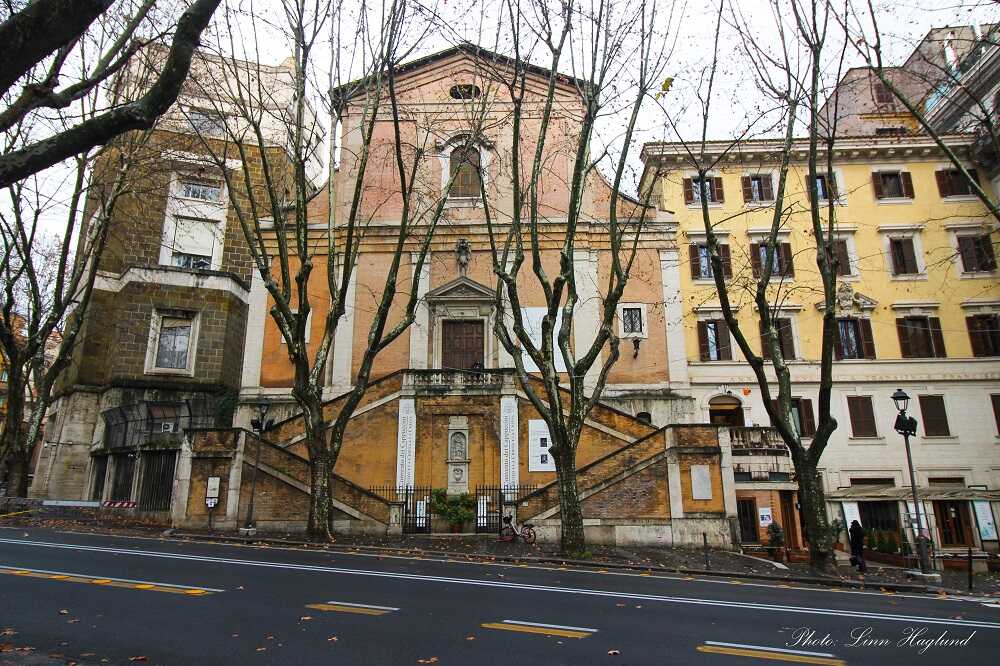
Rome, Lazio, Italy
If you are looking for a unique and chilling experience in Italy, look no further than the capital city.
The Capuchin Crypt–also known as the Bone Chapel–isn’t only off the beaten path in Rome, but relatively unknown in Italy.
Situated near the Piazza Barberini and Palazzo Barberini, it gives you an insight into the history of the Capuchin Order in the museum that you can visit together with the bone chapel.
The chapel itself actually consists of several chapels side by side, carefully ornated with the bones of several thousands of Capuchin friars.
The Capuchins believed this to be a reminder of human mortality.
The walls and ceilings are covered in artwork using different human bones.
Even the chandeliers above your head are made of human bones.
But the most unsettling might just be the skeletons in black capes guarding the chapels.
It is not allowed to take pictures inside the chapels, but this is truly an experience that will stay with you forever.
To get to the Capuchin Crypt, take the metro to Barberini and walk the last couple of minutes. An excellent place to stay nearby is the Relais Barberini Hotel.
From there you can easily walk around a lesser visited part of Rome and explore the astounding Palazzo Barberini, Galleria Nazionale d’Arte Antica and the Chiesa di San Carlino alle Quattro Fontane.
By Linn Haglund from Brainy Backpackers
14. Wander through the gardens at Villa d’Este in Tivoli

Tivoli, Lazio, Italy
Magical Villa d’Este, a UNESCO World Heritage site in Tivoli, is a water fountain lover’s paradise.
UNESCO considers the five hundred water jets scattered through the grounds in fountains, pools, grottoes, and stone statues.
Various other water features a “remarkable illustration of Renaissance culture at its most refined … a true water garden and a unique example of an Italian 16th-century garden,” which became an oft-copied model for others throughout Europe.
The features descend several levels from the Villa’s palace (once a monastery) to the main garden area.
The water for this ambitious project comes to the Villa through an underground canal connected to the Anio River, which flows through the charming town of Tivoli.
The terraced design facilitates the water flow through natural gravity.
One of the most fun features is the water organ. A relatively simple interaction of water and air makes trumpets blow and fills the air with music.
Historical descriptions describe the incredulity with which observers watched the organ produce several madrigal songs as if by magic.
The variety of features play with the water in so many different ways … many of them are whimsical, others ethereal.
There’s no predicting what lies around the next corner, making a genuinely delightful playground for children and adults.
Tickets are reasonably priced, and the hours vary by season.
If you don’t have a car, Villa d’Este is easy to reach by train from Rome, less than an hour away.
From the train station in Tivoli, it’s a simple well-marked walk or bus ride to the Villa. Villa Adriana, the country estate of the Roman Emperor Hadrian and another UNESCO site, is close by (walking distance), and the two villas are taken together, making for a perfect day trip from Rome.
By Shara Johnson from SKJ Travel
15. Visit Palazzo dei Papi, the home for the first-ever conclave in Viterbo

Viterbo, Lazio, Italy
Not many know it, but Viterbo, the capital of the beautiful region of Tuscia (which spans across Northern Lazio, Southern Tuscany, and Umbria), is home to the first-ever conclave.
Quick History: A conclave is a meeting during which Roman Catholic cardinals are literally locked inside a room until they agree on the election of the future pope.
During the 13th century and for about two decades after, Viterbo was considered a much safer place for clerics to live than Rome.
The Palazzo dei Papi (Palace of the Popes) is located in the central Piazza San Lorenzo. Popes resided in this Gothic-style building between 1257 and 1281.
Highlights of the visit include the main room – the Aula del Conclave; the beautifully frescoed Sala Gualterio; and the Loggia della Benedizione – a beautiful balcony overlooking the square below from which the newly elected popes would make their first public appearance.
Viterbo’s Palazzo dei Papi is open daily from 10:00 am to 6:00 or 7:00 pm, depending on the season. Admission is €9 and includes an audio guide that will help you go through the history of the palace and its most notable pieces of art.
Next to the Palace of the Popes, you will find the Duomo di Viterbo, the main church in the city. This Romanesque-style church is the resting place of two 13th-century popes.
You can easily reach Viterbo by train from Rome.
Catch a northbound train from Roma Termini or Roma Tiburtina and get off at Viterbo Porta Romana station.
If you have a car, Viterbo is an excellent base for a road trip around Tuscia.
The best place to stay in town is Hotel Palazzo Verdi (Booking | Hotels), right by the theater and a 2-minute walk to the Corso Italia, from where you can easily reach all the most important landmarks in town.
By Claudia Tavani from Strictly Rome
16. Check out the beautifully preserved ruins of Herculaneum in Ercolano

Ercolano, Campania, Italy
Most people have heard of the ancient ruin of Pompeii, buried by the eruption of Mount Vesuvius thousands of years ago. It’s an incredible place to visit to learn about living in ancient Italy.
Not far away is a smaller, even better-preserved city called Herculaneum. It was on the coast near Mount Vesuvius and where the wealthy people of the time lived.
It’s a UNESCO World Heritage site and a special place worth seeing when visiting Rome, Naples, Sorrento, or the Amalfi Coast.
Though it’s much smaller than Pompeii, it’s in much better condition.
Like Pompeii, it was buried under layers of debris from the eruption. However, you can still see the ancient wood beams, frescoes, and mosaics.
Most of the public buildings remain unexcavated, but what’s remarkable is you can tour many of the wealthy homes to see what they might have once looked like.
You can visit the old baths as well.
It’s generally less crowded, and you can almost hear the echoes of the past. Definitely get a guide to wander through this ruin so you can learn about the history.
Also, there are no facilities inside Herculaneum, so make sure you eat and visit the restrooms at the entrance.
It’s easy to visit Herculaneum as just a ten-minute walk from the Ercolano-Scavi stop on the Circumvesuviana train. Hold your bags close on this local train as it gets pretty busy.
Many people visit on a day trip from Naples or Sorrento and stay in those cities.
If you want to stay closer to the ruin to spend more time there, check out Hotel Herculaneum (Booking | Hotels), just steps from the ruin.
Visiting Herculaneum is a bucket-list experience you won’t want to miss.
By Sam from My Flying Leap
Read More
- 23+ Festive Things to do in Bolzano, Italy at Christmas
- Your Guide for One Day in Pisa, Italy
- The Cost of Living In Rome, Italy: A Local’s Breakdown
- Everything I Wish I’d Known Before Moving To Rome, Italy
- Top Tips for Visiting the Colosseum in Rome, Italy
- The Most Famous Landmarks in Europe
- 3 Days in Milan: A Complete Travel Guide for First-Time Visitors
17. Explore the ruins of the Ancient Greek city Paestum in Paestum

Paestum, Campania, Italy
Italy is home to countless ancient ruins scattered all around the country.
Aside from the deservedly popular site of Pompeii and the lesser-known Herculaneum, there is another significant ruin close to the city.
If you head further south of Naples, you’ll reach the ruins of Paestum, once a major Greek city and one of the most impressive ancient Greek sites anywhere in Europe.
The site’s highlights are the three Doric Greek temples, two dedicated to Hera and one to Athena, in a magnificent state of preservation.
Paestum is also home to a largely intact Greek amphitheater, plus many of the paved roads and buildings foundations remain, allowing you to imagine the ancient city.
Walking around the site and through the temples is an awe-inspiring experience.
Paestum is only a short drive south of Naples, about 75 minutes in a car.
Alternatively, there is a train station within walking distance of the ruins, with regular trains from Napoli Centrale taking just over an hour–so you don’t need to drive if you don’t want to.
It’s also just over half an hour south of Salerno.
The area around Paestum is a popular beach resort area, with multiple lidos to swim at during the summer season.
Over the winter months, the site is relatively quiet, and accommodation can be harder to come by, with the better option to stay in Naples or along the Amalfi Coast.
While in the region, it’s also worthwhile stopping off at one of the many buffalo mozzarella farms dotted throughout the area and signposted from the highway–another one of the coolest, most non-touristy things to do in Italy.
You’ll have the chance to come face to face with the buffalo who produce the famous cheese and purchase some directly from the farm gate.
By Shandos Cleaver from Travelnuity: Dog-Friendly Travel
18. Enjoy panoramic views of the Amalfi Coast from the Villa Cimbrone Gardens in Ravello


Ravello, Campania, Italy
If you’re looking for the best non-touristy things to do in Italy, go to the Villa Cimbrone Gardens in Ravello.
Ravello is a hilltop town on the Amalfi Coast.
Most people visiting the Amalfi Coast just go to Amalfi and Positano, which are super crowded, but it’s definitely worth getting off the path and going to Ravello.
It is a beautiful drive to get there – winding through the hills surrounded by vineyards.
One of the prettiest spots in Ravello is the Villa Cimbrone Gardens.
They are beautifully landscaped gardens. But the best thing about the gardens is the views over the Amalfi Coast.
There is a viewing platform at the very end of the gardens on a cliff that looks out over the Amalfi Coast. It’s worth going to Ravello just for these views.
You can get a bus from most places along the Amalfi Coast to Ravello.
Once you are at Ravello, it’s then a short walk to the Villa Cimbrone Gardens.
The viewing platform is at the very back of the gardens – make sure you don’t miss it since it’s the best part of the gardens and the main reason it’s worth visiting.
If you’re looking for somewhere to stay, you could either remain in Ravello or book accommodation in any of the little villages along the Amalfi Coast if you wanted somewhere a bit more central.
By Ashleigh from Ashleigh’s Atlas
19. Experience one of the fastest zip lines in Europe at Volo dell’Angelo in Castelmezzano

Castelmezzano, Basilicata, Italy
Volo dell’Angelo is situated in the picturesque mountain village Castelmezzano.
Over the town lies one of the fastest zip lines in Europe, where visitors can admire a scenic spot 400 meters above ground level.
It’s one of the numerous non-touristy places to visit in Italy due to its remote destination in the south.
The location is blessed with stunning nature, and the village itself is gorgeous.
That’s why it’s also a hidden gem, known mainly by the locals.
The best things to see and do there are hiking around the beautiful village, visiting Gradinata Normanna, and strolling around a stone village.
But Castelmezzano is known chiefly for the high-speed zip line.
It starts from Castelmezzano, then winds with speeds of 120km/h to the neighboring village Pietrapertosa and back.
It’s better to book “flight” tickets in advance because sometimes there might be long queues.
The best way to get there is by car. There is some public transportation option, but it’s not sufficient enough. It would be an ideal day trip option from Matera.
There are multiple accommodation options in the village to stay a night.
One of them is Casa delle Stelle, which offers magnificent views of the Castelmezzano and surrounding dolomite hills.
By Erki from Genem Travels
20. Discover Matera’s Paleolithic cave homes in the Sassi di Matera

Matera, Basilicata, Italy
Found in the south’s Basilicata region, the city of Matera is home to two incredible non-touristy things to do in Italy.
This magnificent metropolis can be traced back to the Paleolithic period, when ancient peoples lived in the large caves that encircle today’s city center.
When I was teaching English in Italy in Matera, my host family and I spent a day climbing up to these caves.
However, the city is most famous for its Sassi di Matera.
The Sassi is made up of structures and residences carved into the side of the mountain.
While these exquisite white stone houses were abandoned for many years beginning in the 1950s from poor sanitation, they have now been refurbished and restored to modern-day standards.
Today, you must explore the Sassi’s twisting streets and discover locally-owned stores and excellent restaurants.
You can also discover some outstanding, one-of-a-kind apartment stay properties to rent during your vacation in this historic area.
If time allows, visit the Palombaro Lungo, a now-inactive underground water reservoir once the largest in the ancient city.
This historical way of delivering water to the town’s residents was critical to the city’s survival.
Spend an afternoon with a tour guide wandering through these fifteen-meter-high tunnels and learning how the city’s people received water.
While Matera is a beautiful city to explore during the day, the city comes alive in the evenings.
Their central plaza, Piazza Vittorio Veneto, is bustling with families and friends out for after-dinner strolls.
Although the city’s popularity has soared since it was chosen as a 2019 European Capital of Culture, you’ll still be immersed in authentic Southern Italian culture when you visit the ancient city.
By Lyndsay from The Purposely Lost
21. See the seaside cave church in Pizzo Calabro, Piedigrotta Church

Pizzo Calabro, Calabria, Italy
When in Pizzo Calabro, in the province of Vibo Valentia in Calabria, you can’t miss a visit to the Piedigrotta Church.
The church is only 20 minute’s walk from Pizzo city center, or just 5 if driving a car and following the road SS 522.
To get to the stunning cave church, you’ll walk down a granite flight of steps and pass through a scenic path facing the Gulf of Sant’Eufemia.
The Piedigrotta Church is a seaside cave church with carved sculptures from the 19th and 20th centuries.
The Piedigrotta church is unique because the religious place was carved on sedimentary rocks of marine origin, even if improperly defined by many as a cave dug into the earth.
The stone facade is quite simple and made of poor materials.
The true wonder is its interiors: three caves with statues created from the same sedimentary rock narrating scenes from the Holy Scriptures.
It’s believed that the church was carved as a devotion act for the Madonna of Piedigrotta.
The legend says that the painting of this Madonna and the crew were able to save themselves after a catastrophic shipwreck, and building the church was a way to thank her.
This little gem is only a step away from the beautiful Piedigrotta Church’s beach, where you can spend some time sunbathing and relaxing.
Alternatively, you can drive back to Pizzo and explore the narrow streets and piazzas of the small historical city center.
If you decide to do that, you can’t leave without trying the tartufo di Pizzo, a delicious gelato dessert composed of many layers of gelato flavors!
You can stay at the Palazzo Paladini for a wonderful stay in modern and luxurious flats right in the city center of Pizzo Calabro.
By Dan from Urban Abroad
22. Swim inside Roca Vecchia’s Grotta della Poesia, the “Cave of Poetry”

Roca Vecchia, Puglia, Italy
The Grotta della Poesia is a natural sea cave with an intriguing history.
Rumored to have been frequented by an enchanting Princess, the cave drew in poets inspired by the scene’s beauty – hence the name, which translates to “Cave of Poetry” in English.
Fairytales aside, there is evidence that the cave was used in worship throughout history, dating back to the Messapian period.
Today, the caves are frequented by locals and tourists alike who come to sunbathe on the cliffs, dive into the natural pool, or explore other nearby archaeological ruins.
It’s a truly beautiful and unique place to swim.
And if you’re not brave enough to dive into the crystalline water from above, there’s a stone staircase etched into the side of the cave for a more demure entrance.
From the cave, it’s possible to swim out to the sea, but beware that the sea can be rough on the other side of the thick rocky sea wall, so this is best only untaken by strong swimmers.
While you’re in the area, be sure to take a walk along to the Archeology park of Roca Vecchia, which is hidden in plain sight.
Here you’ll find ruins dating back to the 14th century BC. The cave is easily reached via car, or you can take a bus from Lecce, which will take about an hour.
Nearby Torre dell’Orso and San Foca are among the best places to stay in Puglia, and both are within walking distance of the cave.
Consider a stay at the Hotel Belvedere (Booking | Hotels), and you’ll be able to wander along the coast for about 15 minutes to be first in line for a morning swim at the grotto.
By Nadine Maffre from Le Long Weekend
23. Explore the Medieval city center of Erice

Erice, Sicily, Italy
The village of Erice in western Sicily (Trapani province) contains two parts: The modern part of the city at the bottom of the hill and the medieval village precariously perched on the aptly named Mount Erice (750 meters or 2.460 feet above sea level).
The real reason for visiting Erice lies not in the modern part of town but hidden deep between the quaint alleys of historical Erice, where time has somehow stood still.
Highlights of Erice include Porta Trapani, Church of San Martino (a Norman Church), Mother Church, a walk through the Spanish Neighborhood, and of course, a visit to the extraordinarily well preserved Venus Castle, overlooking the Egadi Islands.
As is the case for many typical Sicilian villages, Erice has its very own typical and age-old biscuits to try: Genovesi Ericine or Mustaccioli is a local favorite.
There are a few different ways to get to the Historical Center of Erice, the most scenic being the cable car (starts in Via F. Milana, 102, 91016 Erice TP, Italy) which runs from April on (€6.00 one way or €9.50 to and back).
Alternatively, drive up the winding roads and park outside Porta Trapani (€1/hour parking fee to be paid with cash at the meter).
By Caroline from Veggie Wayfarer
24. Marvel at the huge collection of Roman mosaics at the Villa Romana del Casale near Piazza Armerina
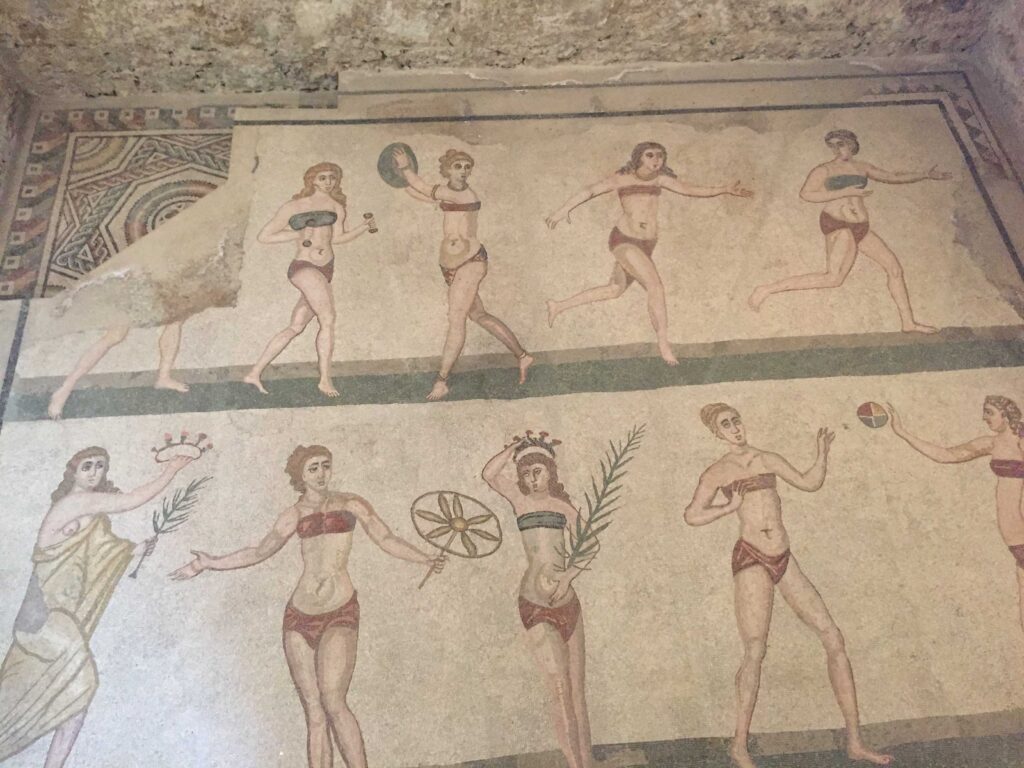
Piazza Armerina, Sicily, Italy
Villa Romana del Casale is an incredible UNESCO site located near the town of Piazza Armerina in central Sicily, Italy.
The site contains a vast collection of Roman mosaics, remarkably well preserved over the centuries.
The house is thought to have belonged to a wealthy Roman family – the excavated rooms were likely once used for administrative and residential purposes.
The mosaics are particularly colorful and skilfully produced, depicting various scenes, including hunting and fighting, mythical stories, and everyday Roman life.
The craftsmen who created the beautiful mosaics are thought to have come from North Africa.
Villa Romana del Casale is very rural, so it is best reached by car or as part of a guided tour.
The site is around 160 kilometers from the capital of Sicily – Palermo – and 100 kilometers from Catania.
There are some wonderful small Italian towns and villages to explore in the vicinity of the Roman site, including the hilltop town of Enna.
The best places to stay nearby are the family-run agriturismo farm stays such as Baglio Pollicarini, which is a unique place in Italy on its own.
This important archaeological site is one of the essential non-touristy places to visit in Italy for anyone interested in Roman history visiting Italy.
By Annabel Kirk from Smudged Postcard
25. Escape to the Dolomite Mountains from Bolzano

Bolzano, Trentino-Alto Adige/Südtirol, Italy
Nestled in the heart of the Dolomite Mountains, Bolzano is a stunning city that offers a unique blend of Italian and Austrian cultures.
While it may not be as well-known as other Italian destinations, Bolzano is a hidden gem that boasts a wealth of historical and cultural treasures.
Visitors can explore the city’s medieval center, which is home to several impressive landmarks, including the iconic Duomo and the South Tyrol Archeological Museum.
Just outside the city center, you can visit the imposing, Medieval castle, Castel Mareccio, or take the cable car Funivia Renon for incredible views of the mountains.
As an excellent gateway to the stunning Dolomite Mountains, offering access to some of the most breathtaking natural landscapes in Italy, Bolzano offers some of the best non touristy things to do in Italy.
It’s also home to one of the largest Christmas markets in Italy.
26. See the ancient trulli houses in Alberobello
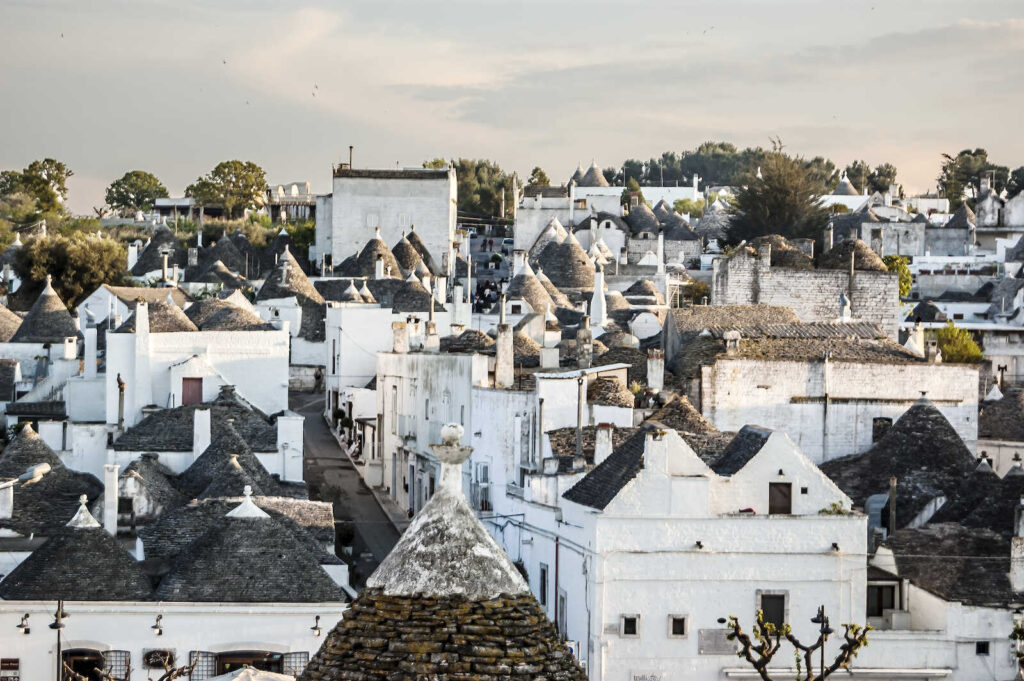
Alberobello, Puglia, Italy
Found in the southern region of Puglia, Alberobello is a small town that has managed to preserve its unique character and history.
What makes this town stand out is its unusual architecture – the town is dotted with dozens of traditional trulli, small stone houses with conical roofs that date back to the 14th century.
The town’s historic center is a UNESCO World Heritage Site, and visitors can stroll along the winding streets and marvel at the trulli that dot the landscape.
Alberobello also boasts a rich culinary tradition, with local specialties such as orecchiette pasta, burrata cheese, and Primitivo wine.
27. Marvel at panoramic views of Lake Garda in Sirmione

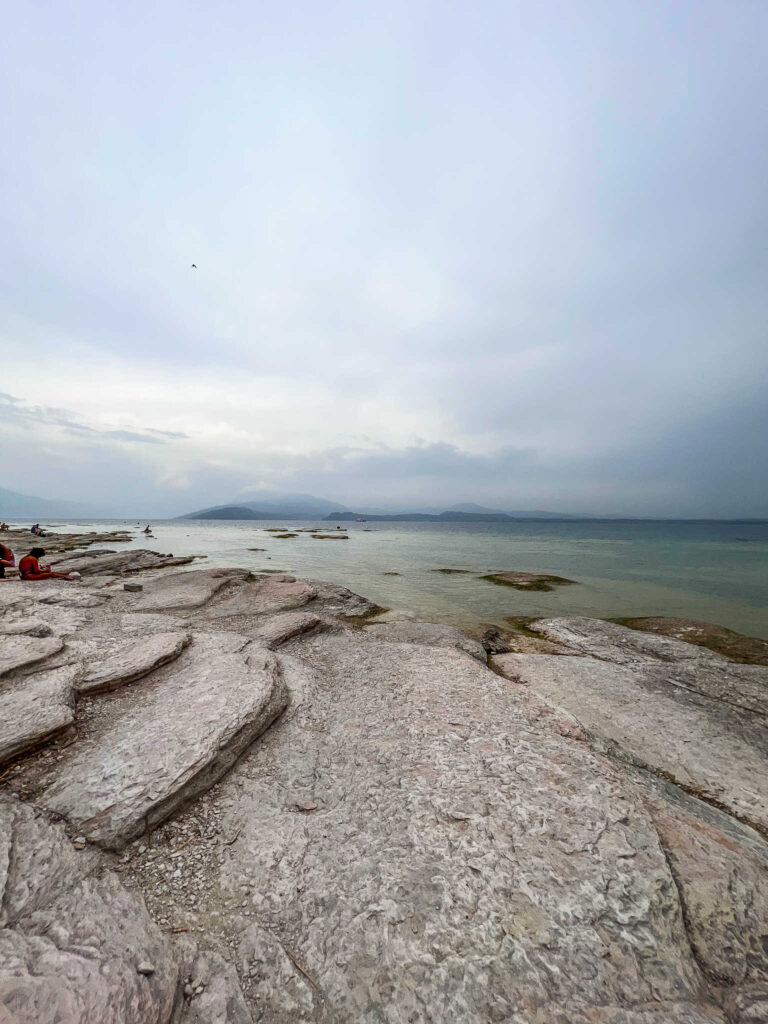
Sirmione, Lombardy, Italy
Sirmione is a charming town located on a narrow peninsula that juts into Lake Garda, Italy’s largest lake.
Despite its stunning beauty and historic significance, Sirmione remains relatively undiscovered by tourists, making it a hidden gem that’s worth exploring.
The town is home to several impressive Roman ruins, including the ruins of a grand villa and a 13th-century castle that overlooks the lake.
Visitors can also take a dip in the lake or the town’s thermal baths and Italian hot springs or stroll along the winding streets of the historic center.
With its picturesque setting, rich history, and laid-back vibe, Sirmione is undoubtedly one of the most extraordinary non-touristy places to visit in Italy.
28. Spend a night in one of Europe’s oldest castles at CastelBrando
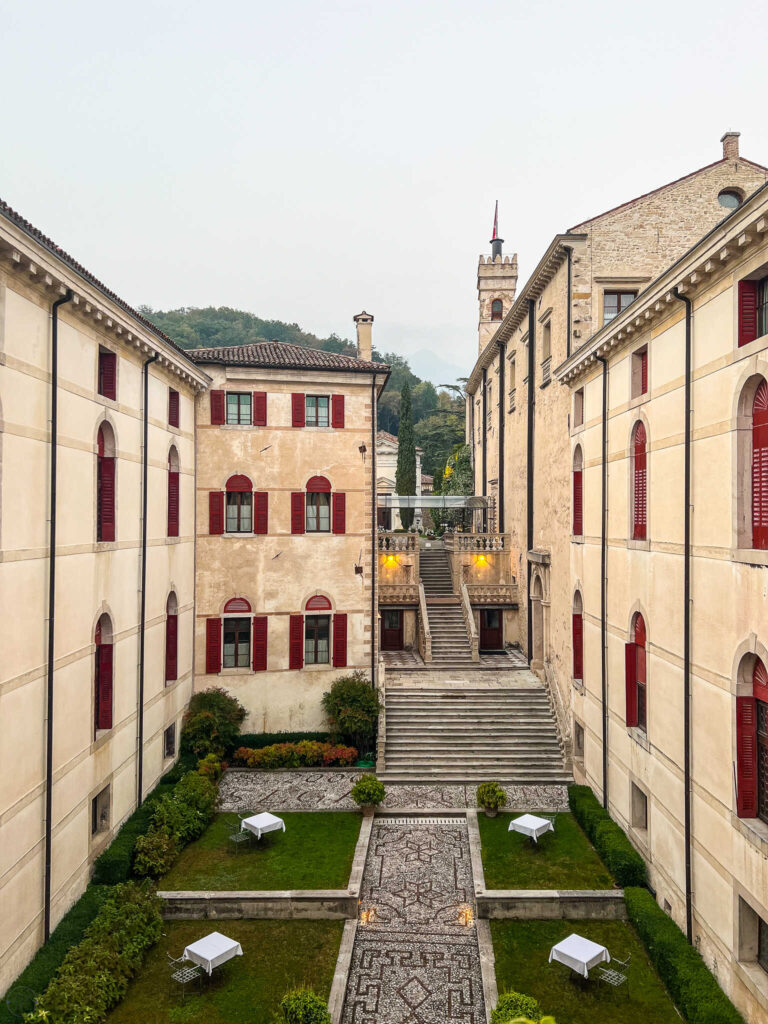

Cison di Valmarino, Veneto, Italy
Found right in the heart of the Veneto’s UNESCO-protected Prosecco Hills, CastelBrando is a medieval castle that has been converted into a unique hotel and spa.
The castle’s rich history dates back all the way back to the Romans when it was first built as a fortress.
Later, the ruling families of the region expanded the structure and developed it into the castle it is today.
Now, CastelBrando has been beautifully restored and offers luxurious accommodations, spa treatments, and dining options.
Guests can explore the castle’s many rooms and halls, take in breathtaking views of the surrounding countryside from the castle’s towers, and enjoy the finest Prosecco, either on a Prosecco tour or in the castle’s restaurant or bar.
If you’re interested, you can read more about my experience visiting this historic site in my complete CastelBrando review.
29. Climb one of the remaining Medieval towers in San Gimignano
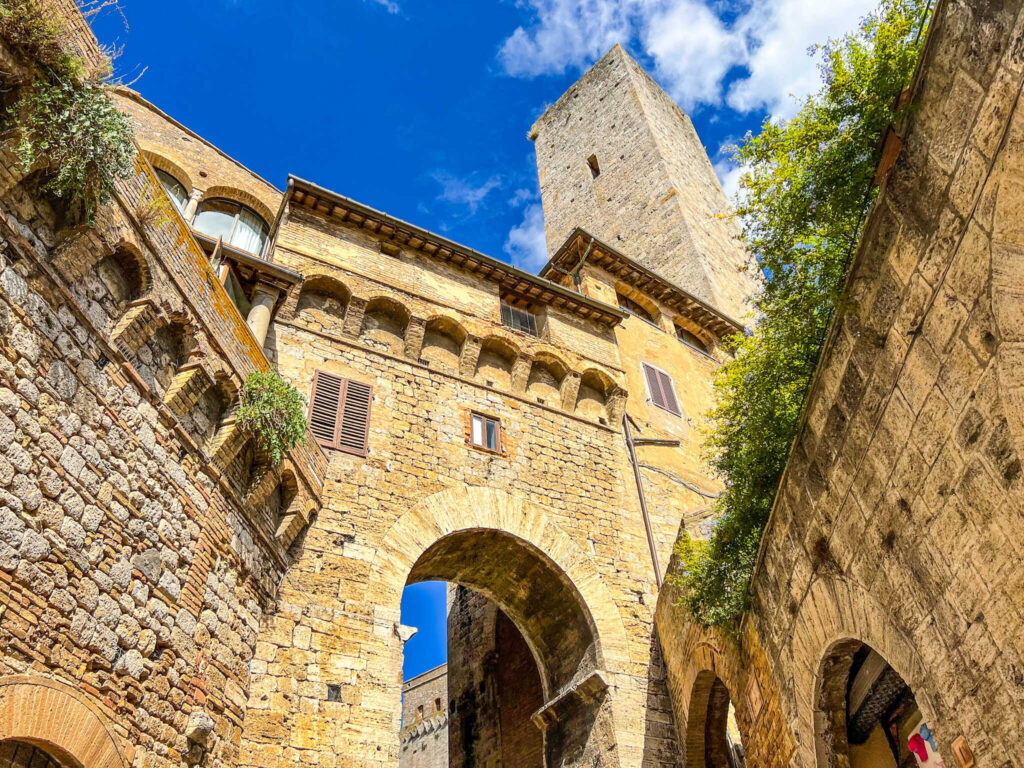
San Gimignano, Tuscany, Italy
San Gimignano is a small medieval town that has managed to preserve its authentic character and charm over the centuries.
Often overshadowed by more famous Tuscan destinations like Florence and Siena, San Gimignano is a hidden gem that should not be missed by those seeking an off-the-beaten-path experience.
The town is famous for its many towers, which were built by wealthy families during the Medieval period as a sign of their wealth, status, and for protection.
Stroll along the town’s narrow streets, take in stunning views of the surrounding hills and vineyards, and sample local specialties such as Vernaccia di San Gimignano wine and saffron-flavored dishes.
And, you must taste some of the best gelato in Italy, found at Gelateria Dondoli in the town’s piazza.
30. Dip your toes in the Tyrrhenian Sea on the Aeolian Islands

Aeolian Islands, Sicily, Italy
Off the coast of Sicily, you’ll find a stunning archipelago–the Aeolian Islands.
Comprised of seven islands and relatively undiscovered by tourists, the Aeolian Islands offer a unique blend of natural beauty and Mediterranean heritage.
Visitors can explore the islands’ volcanic landscapes, take a dip in the crystal-clear waters of the Tyrrhenian Sea, and sample delicious seafood dishes at local restaurants.
Each island has its own distinct character and attractions, from the dramatic cliffs of Stromboli to the stunning beaches of Panarea.
With its pristine beaches, rugged terrain, and laid-back vibe, the Aeolian Islands are undoubtedly one of the most extraordinary non-touristy places to visit in Italy.
The Best Non-Touristy Things to do in Italy
If you’re planning a trip to this beautiful country, there are some absolutely incredible non touristy places in Italy you definitely need to visit.
Although they’re off the beaten path, they offer truly unique experiences and beautiful views that will leave you wanting more.





